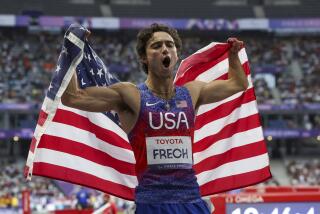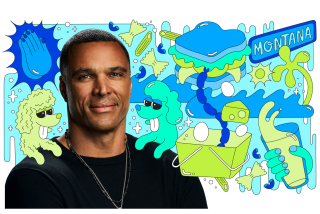League of Nations
On South Fairfax Avenue, in a two-block area, there is a gathering of Ethiopian restaurants and food stores. Near the Miracle Mile and not so far from Hancock Park, where the first silent film stars built their fancy cottages, is Little Ethiopia.
Here is the Messob Ethiopian Restaurant. Brothers Getahun and Berhanu Asfaw own the restaurant and on the wall they have photos of celebrities, American and Ethiopian. On the wall are photos of two runners, a man and a woman, who ran for their lives and for their country. Abebe Bikila won two Olympic marathon gold medals (in 1960 and 1964); Fatuma Roba won Olympic gold in 1996.
It is with awe that Getahun Asfaw points to the photos. “Heroes, great heroes,” Asfaw says. “In Ethiopia we run to live, we live to run and because of that we are honored to have the runners pass our restaurant [today]. Our welcome will be warm.”
The Los Angeles Marathon route will carry runners past the front door of the Messob Ethiopian Restaurant today. This will be near Mile 18 and when they reach the Messob, runners may not notice the spicy smells or see the Ethiopian flag and American flag, or the balloons or the cheering brothers, who will be shouting their good wishes. But all that will be there.
“It is a great thing to see the diversity of this city,” Berhanu Asfaw says, “and with the marathon you can do that.”
Unlike any other sporting event, a marathon belongs deep in the heart of its city. Run the Boston Marathon, you know you aren’t in New York. Run the New York Marathon, you know you aren’t in Paris.
A marathon is a celebration of great athletic achievement, but it couldn’t happen without thousands of volunteers who come out to offer water, put up portable toilets, hand out bib numbers and cold towels, clean up the after-effects, the dirt and worn-out shoes, to stand at the finish line hours after the leaders have finished to welcome the 80-year-old great-grandfather or the 15-year-old rookie.
Running the Los Angeles Marathon introduces the athlete to the smells of the city, to the hint of wasabi in the air as he passes the New Otani hotel, to the scent of old popcorn and wondrous triumphs as she passes the Coliseum, to the sniff of bulgogi in Koreatown.
Running the Los Angeles Marathon is a treat to the ears and eyes of runners and of fans. At 29th and Crenshaw there will be the John Muir Alumni Drummers pounding out a beat of perseverance.
At 6th and Wilton the Latin Band will encourage somebody to dance a little salsa.
Pastor Marco Rojas and his Set Free Ministries of Carson will bus in the Set Free All-Stars to do a little break-dancing and help pass out water. The Set Free Choir, as Pastor Rojas says, will “sing out a little sanctified holy rock and roll,” at the corner of Olympic and Vermont, right around Mile 24 when the runners need a little push from above.
As the runners pass through Hancock Park, the local citizens will sit in lawn chairs and shout encouragement and the children will offer cups of water and lemonade. On the corner of Pico and Fairfax, the runners’ mouths will water when they see the Mo Better Meatty Meat Burgers restaurant and their eyes will widen when they turn the corner at Pico onto Fairfax and see in the distance the Hollywood sign.
Maybe they will smile as they pass the original Automobile Club of Southern California building, marvel at the beautiful architecture, chuckle at the homage Californians paid almost immediately to the automobile. Running past AAA. Oh, the irony!
The course passes Staples Center, our new athletic palace, at the three-mile mark, and then our old athletic palace, the Coliseum, less than two miles farther.
Pat Connolly, once a Los Angeles police sergeant, now retired, and a 62-year-old coach of the Los Angeles Roadrunners, will lead a group of 2,000 of his racers from the Wilshire Grand Hotel to the start line at 2nd and Grand this morning.
He knows this course, has driven it dozens of times, can point out every pothole and mile marker. He can still smell the freshness of the bread that used to be delivered from the Helms Bakery on Venice. “Helms Olympic Bread--Daily at Your Door,” says the sign. “Citius, Altius, Fortius.”
“They put up that sign around the 1932 Olympics,” Connolly says. “Everybody in town used to get their bread from Helms.” Now the rehabilitated building is a small shopping center. But the sign remains and marathoners will pass.
“That’s Hamilton High School,” Connolly says as he passes the school on Robertson. “They’ve filmed a lot of movies there.”
Connolly’s tour is an overview of all that is good about Los Angeles. The runners must make a U-turn at Pico and Robertson, to make sure it is a complete marathon, 26 miles, 385 yards. At the U-turn corner is Pico Kosher and the B’Nai David Judea temple. In one block on Pico the athletes will pass Alef Market, Twin Dragon Shanghai and Zafar Market--Middle Eastern, Chinese, Middle Eastern.
“When you are out and pounding the pavement,” says Terry Jones, “you see the faces of the people in the community and each face tells you a story. You are really getting up close. When you look at the faces in Los Angeles, the story is of diversity and of a great, great spirit. I wish everybody could get out and run the course of the Los Angeles Marathon.”
Jones has run in previous L.A. Marathons and he has also been a volunteer worker. He now lives in Atlanta but still comes back the week before the marathon to be, as he says, “a go-fer and then to run.”
Nawania Lyles works at KALI (900), a Christian radio station. She hosts a gospel radio show on the weekends and is an administrative assistant during the week. At marathon time, Lyles coordinates the placement of several gospel singing groups around Exposition and Martin Luther King boulevards.
“We’ll have people running from our local churches and people singing,” Lyles says. “We’ll have people who come up to us and say they were on their very last breath and heard our music and were able to go on. We have people come up to our singers and say how happy they are to run through a part of the city they would otherwise never see.”
*
Diane Pucin can be reached at [email protected]
More to Read
Sign up for The Wild
We’ll help you find the best places to hike, bike and run, as well as the perfect silent spots for meditation and yoga.
You may occasionally receive promotional content from the Los Angeles Times.






